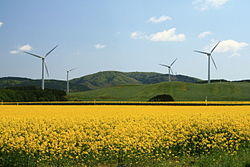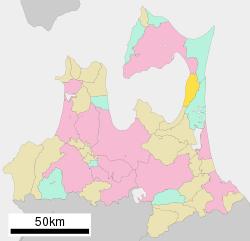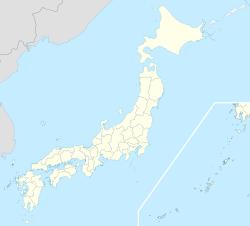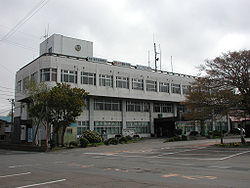Yokohama 横浜町 | |
|---|---|
 Windpower farm in Yokohama | |
 Location of Yokohama in Aomori Prefecture | |
| Coordinates: 41°04′59.3″N 141°14′52.1″E / 41.083139°N 141.247806°E | |
| Country | Japan |
| Region | Tōhoku |
| Prefecture | Aomori Prefecture |
| District | Kamikita |
| Area | |
| • Total | 126.38 km2 (48.80 sq mi) |
| Population (April 1, 2020) | |
| • Total | 4,412 |
| • Density | 35/km2 (90/sq mi) |
| Time zone | UTC+9 (Japan Standard Time) |
| - Tree | Keyaki |
| - Flower | Rapeseed |
| - Bird | Plover |
| - Fish | Sea cucumber |
| Phone number | 0175-78-2111 |
| Address | Teranoshita 35, Yokohama-machi, Kitakami-gun, Aomori-ken 039-4145 |
| Website | Official website |
Yokohama (横浜町, Yokohama-machi) is a town located in Aomori Prefecture, Japan. As of 1 July 2020, the town had an estimated population of 4,171, and a population density of 33 persons per km², in 1,779 households.[1] The total area of the town is 126.38 square kilometres (48.80 sq mi).
Geography
Yokohama occupies the northeastern coastline of Mutsu Bay, at the entrance to Shimokita Peninsula.
Neighbouring municipalities
Aomori Prefecture
Climate
The town has a cold maritime climate characterized by cool short summers and long cold winters with heavy snowfall (Köppen climate classification Cfb). The average annual temperature in Yokohama is 9.1 °C. The average annual rainfall is 1262 mm with September as the wettest month. The temperatures are highest on average in August, at around 21.9 °C, and lowest in January, at around -2.6 °C.[2]
Demographics
Per Japanese census data,[3] the population of Yokohama has declined over the past 60 years.
| Year | Pop. | ±% |
|---|---|---|
| 1920 | 3,316 | — |
| 1930 | 4,173 | +25.8% |
| 1940 | 5,016 | +20.2% |
| 1950 | 7,068 | +40.9% |
| 1960 | 7,742 | +9.5% |
| 1970 | 7,144 | −7.7% |
| 1980 | 6,590 | −7.8% |
| 1990 | 6,126 | −7.0% |
| 2000 | 5,508 | −10.1% |
| 2010 | 4,880 | −11.4% |
History
The area around Yokohama was controlled by the Nambu clan of Morioka Domain during the Edo period. During the post-Meiji restoration establishment of the modern municipalities system on 1 April 1889, it was proclaimed to be a village. Yokohama was elevated to town status on April 1, 1958.
Government
Yokohama has a mayor-council form of government with a directly elected mayor and a unicameral town council of ten members. Yokohama is part of Shimokita District which, together with the city of Mutsu, contributes three members to the Aomori Prefectural Assembly. In terms of national politics, the city is part of Aomori 1st district of the lower house of the Diet of Japan.
Economy
The economy of Yokohama was traditionally heavily dependent on commercial fishing in Mutsu Bay, primarily for sea cucumber, the local specialty, as well as sea urchin roe and scallops. With regards to agriculture, rapeseed and potato farming predominates. Electrical power production via wind farms also contributes to the local economy.
Education
Yokohama has one public elementary school and one public middle school operated by the town government. The town does not have a high school.
Transportation
Railway
![]() East Japan Railway Company (JR East) - Ōminato Line
East Japan Railway Company (JR East) - Ōminato Line
- Fukkoshi, Mutsu-Yokohama, Arihata
Highway
 Shimokita Expressway
Shimokita Expressway National Route 279
National Route 279
References
- ^ "Aomori Prefecture Estimated Population 2020" 青森県の推計人口 令和2年. Aoi Mori Open Data Catalog. Retrieved August 18, 2020.
- ^ Yokohama climate data
- ^ Yokohama population statistics
External links
![]() Media related to Yokohama, Aomori at Wikimedia Commons
Media related to Yokohama, Aomori at Wikimedia Commons
- Official Website (in Japanese)



